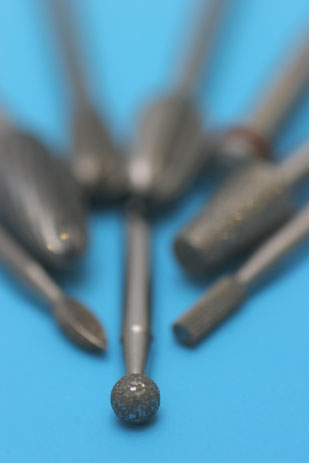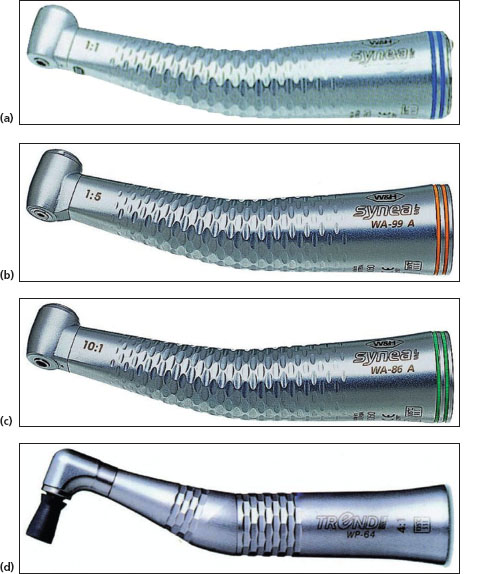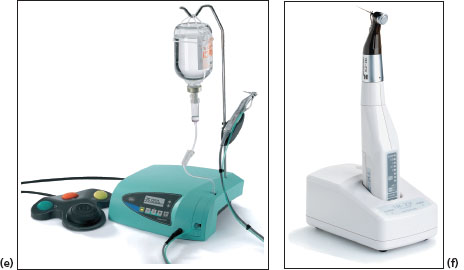SECTION 7
HANDPIECES, BURS AND ROTARY ATTACHMENTS
Dental handpieces and rotary attachments help to make dental treatment more comfortable for the patient and reduce the amount of time needed to complete procedures.


HANDPIECES
FIGURE 7.1
Name
Air turbine handpiece. Also called: fast handpiece, high-speed handpiece and air rotor handpiece
Type
Contra-angled
Functions, precaution and features
- Removal of tooth tissue during restorations and preparation of teeth for fixed prosthetic appliances
- Polishing of restorations
- High speeds create heat and friction – handpiece must be run with water to cool the tooth to prevent pulpal damage
- High speed saves treatment time and reduces vibration
- High speed but low torque handpiece will stall with moderate pressure
Driven by
- Turbine – may need to be lubricated – check manufacturer’s instructions
- Compressed air rotates the turbine, which then rotates the bur
Speed
Check manufacturer’s specifications (can run up to 500 000 rpm)
Grip
Accepts friction grip attachments
Attachment
Dental unit
Varieties
- Different types of chucks available (e.g. those which need bur changing tool)
- With or without light
- Smaller heads for difficult access or use with the paediatric patient


FIGURE 7.2
Name
Straight handpiece
Type
Straight
Functions
- Used in surgical procedures to remove bone (cannot use air turbine as the water is not sterile)
- Used extra-orally at chairside or in the dental laboratory (e.g. for denture adjustments)
Driven by
Gears
Speed
Check manufacturer’s specifications (can run up to 40 000 rpm)
Grip
Accepts long shank attachments
Attachment
Electric motor that fits into the base of the handpiece
FIGURE 7.3
Name
Electric motor
Features
- Can reach speeds of 100 000 rpm depending on the type of attachment
- It is attached to the dental unit


FIGURE 7.4a, b, c, d, e, f
Name
Conventional handpieces. Also called: slow-speed handpieces and low-speed handpieces
Type
Contra-angled
Functions
- Removal of caries
- Polishing
- Procedures that require torque
- Refine cavity preparations and adjust occlusion
Driven by
Gears
Speed
Varies depending on handpiece
Grip
Varies depending on handpiece
Attachment
Electric motor that fits into the base of the handpiece (see Figure 7.3)
Exa/>
Stay updated, free dental videos. Join our Telegram channel

VIDEdental - Online dental courses


